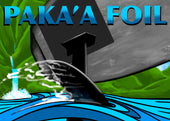High Aspect Versus Medium Aspect Front Foil Wings
The aspect ratio (AR) of a foil wing is that ratio of its span (measuring wing tip to wing tip) to its average chord (front to back distance). A low aspect wing would be similar to a fighter aircraft (designed for maneuverability) and a high aspect wing would be similar to a glider, designed to stay aloft.

Every foil size and shape has a slightly different stall speed or lift speed, just like an airplane wing. Short thick foils have a lift speed around 6mph or lower. Wide and thin wings (high aspect) have a higher lift speed, so you will need more board speed to pop up on foil.
For foiling, high aspect wings have great glide and are more efficient at pumping (less force and slower cadence when pumping), but they are harder to turn and recover from a turn (they require more force on the opposite side of the board to come back to neutral). Because high aspect wings are typically thinner than medium aspect wings (and with a shorter chord), they have a higher top-end speed, but also have a higher low-end stall speed or lift speed.
Medium aspect wings have better turning and recovery, but less glide and require more force to pump. Medium aspect wings are generally thicker giving lift at slower speeds (a longer chord helps too), but have a lower high-end speed than high aspect. Medium aspect wing are much easier to learn on than high aspect, and are the best blend of attributes to get started. Once is rider is able to pump to stay on foil and doing good turns and recoveries, as well as jibe or tacks while winging, a higher aspect foil should be considered. The Konrad foil is an excellent choice for beginners and has modular upgrades for front wings when the rider is ready to progress. Konrad Alloy Foil
A unique design difference is that the KT Atlas and Nomad series wings while having a high AR, they also have a great low end as well due to a high camber on the trailing edge, similar to having the flaps extended on a plane when landing. This does not greatly affect the high-end speed with the Atlas 1160 for example having a stall speed of 6.5 mph and top speed of 28mph. For me, the KT Nomad and Atlas foils are the best on the market, the next level of performance. KT Nomad Foil set
Downwind specific wing are now getting to be over AR 10 and even high teens now for channel crossing or racing wings. But that's when speed is the most important factor, for us we prefer to foil the flow for fun.
Mathematically, Aspect Ratio (AR) equals span X span / area. High aspect wings have AR around 8-12+, medium have about 4-6, low aspect wings have AR of 3 or less.
Low aspect wings are mostly first generation wings and are not recommended. If possible try out several different AR wings before you buy or ask a shop for advice. That way, your foiling experience will see greater progression quicker and not suffer through as many humbling sessions.





